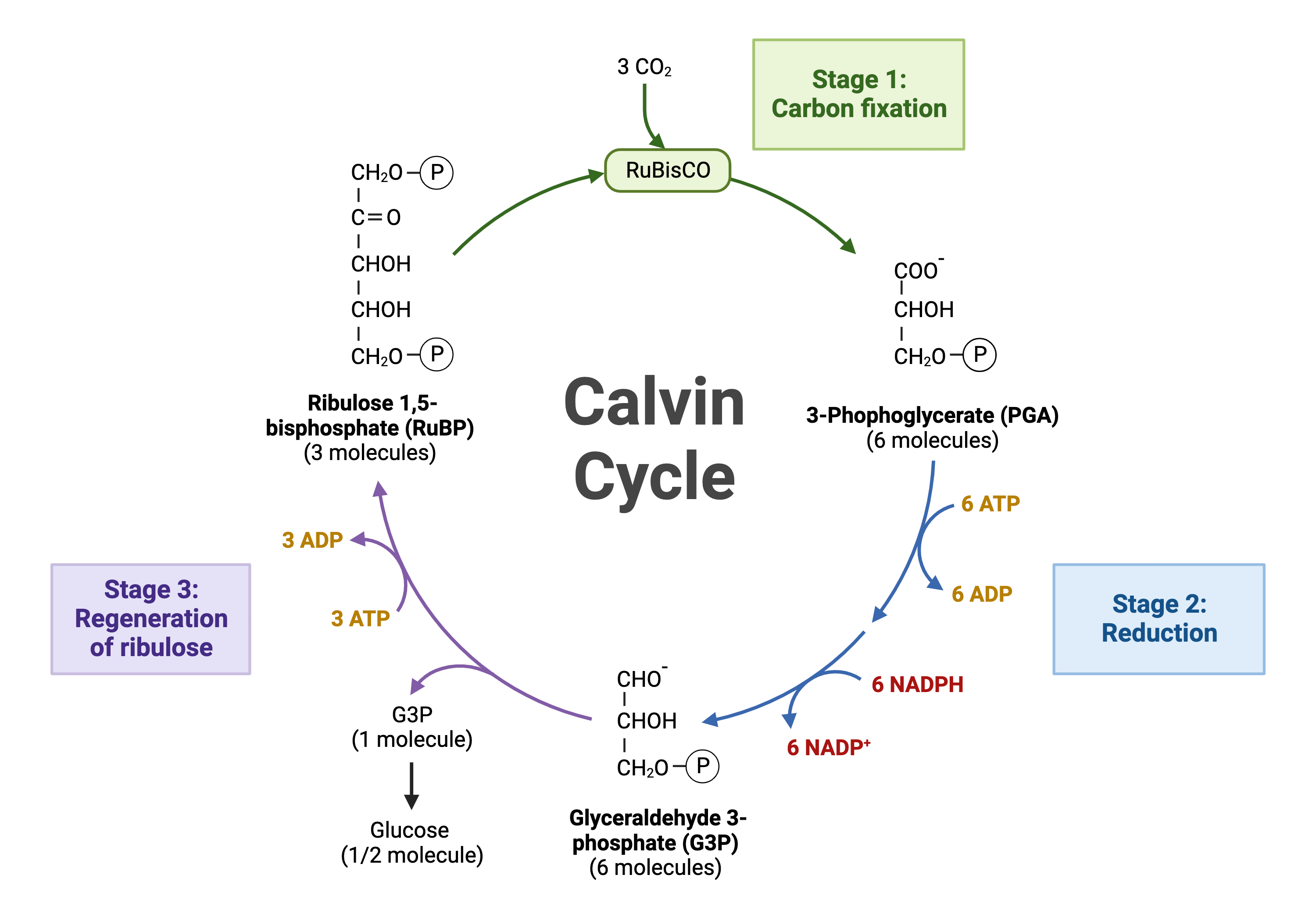Photosynthesis is a remarkable process that sustains life on Earth, and at the heart of this process lies the Calvin Cycle. This cycle, a vital component of photosynthesis, plays a crucial role in transforming carbon dioxide into glucose, which plants use for energy and growth. Let’s explore the Calvin Cycle’s phases, significance, and the complex mechanisms that enable it.
Understanding Photosynthesis
Before exploring the Calvin Cycle, it is important to grasp the overall context of photosynthesis. This process allows green plants, algae, and some bacteria to convert light energy into chemical energy and occurs in two main stages: the light-dependent reactions and the light-independent reactions, or Calvin Cycle.
The Role of Photosynthesis in Plant Life
Photosynthesis is the lifeblood of plant life, providing the energy needed for growth, reproduction, and survival. It also produces oxygen, a byproduct that is essential for the respiration of most living organisms on Earth.
The Two Main Stages of Photosynthesis
- Light-Dependent Reactions: These occur in the thylakoid membranes of chloroplasts, where sunlight is captured and used to generate ATP and NADPH.
- Light-Independent Reactions (Calvin Cycle): These take place in the stroma of chloroplasts and use the ATP and NADPH produced in the light-dependent reactions to fix carbon dioxide into glucose.
Now that you have a basic idea of photosynthesis, let’s take a closer look at the Calvin Cycle and how it works in more detail.
Calvin Cycle Full Explanation

What is the Calvin Cycle?
The Calvin Cycle, also known as the C3 cycle, is a crucial part of photosynthesis in plants. It is a series of biochemical redox reactions that take place in the chloroplasts’ stroma and convert carbon dioxide (CO₂) and hydrogen-carrier compounds into glucose.
This cycle uses the energy from ATP and the reducing power of NADPH (both produced during light-dependent reactions) to create sugars that the plant can use for growth and survival. Essentially, it’s how plants turn CO₂ into energy-rich molecules!
It is named after Melvin Calvin, who, along with his colleagues, elucidated the cycle’s details in the 1950s.
Historical Background
Melvin Calvin and his team used radioactive carbon (14C) to trace the path of carbon in photosynthesis, leading to the discovery of the cycle that bears his name. This groundbreaking work earned Calvin the Nobel Prize in Chemistry in 1961.
Key Components of the Calvin Cycle
Carbon Dioxide (CO2)
Carbon dioxide is a crucial input for the Calvin Cycle. Plants absorb CO2 from the atmosphere through small openings in their leaves called stomata.
RuBP is a five-carbon sugar molecule that plays a key role in the initial step of the Calvin Cycle. It acts as a carbon acceptor, combining with CO2 to form a six-carbon compound.
ATP and NADPH
ATP (adenosine triphosphate) and NADPH (nicotinamide adenine dinucleotide phosphate) are energy-rich molecules produced during the light-dependent reactions of photosynthesis. They provide the energy and reduce the power needed for the Calvin Cycle.
Phases of the Calvin Cycle
The Calvin Cycle can be divided into three main phases:
Carbon Fixation
In this phase, CO2 is attached to RuBP by the enzyme Rubisco, forming an unstable six-carbon compound that immediately splits into two molecules of 3-phosphoglycerate (3-PGA).
Reduction Phase
During the reduction phase, ATP and NADPH are used to convert 3-PGA into glyceraldehyde-3-phosphate (G3P), a three-carbon sugar. This phase involves several intermediate steps and the action of various enzymes.
Regeneration of RuBP
In the final phase, some of the G3P molecules are used to regenerate RuBP, ensuring the cycle can continue. This process requires ATP and involves a complex series of reactions.
Detailed Breakdown of Each Phase
Carbon Fixation Process
- CO2 enters the cycle: Carbon dioxide molecules enter the cycle from the atmosphere.
- Formation of a six-carbon compound: CO2 combines with RuBP, catalyzed by the enzyme Rubisco.
- Splitting into 3-PGA: The resulting six-carbon compound splits into two molecules of 3-PGA.
Reduction Phase
- Phosphorylation of 3-PGA: ATP donates a phosphate group to 3-PGA, forming 1,3-bisphosphoglycerate.
- Reduction by NADPH: NADPH donates electrons to 1,3-bisphosphoglycerate, reducing it to G3P.
Regeneration Phase
- Formation of RuBP: Five molecules of G3P are rearranged into three molecules of RuBP.
- Use of ATP: ATP is required to phosphorylate intermediates in this process.
Enzymes Involved in the Calvin Cycle
Role of Rubisco
Rubisco (ribulose-1,5-bisphosphate carboxylase/oxygenase) is the enzyme responsible for fixing CO2 to RuBP. It is the most abundant protein on Earth and plays a critical role in the Calvin Cycle.
Other Key Enzymes
Several other enzymes, such as phosphoglycerate kinase and glyceraldehyde-3-phosphate dehydrogenase, are involved in the various steps of the Calvin Cycle.
Energy Requirements of the Calvin Cycle
ATP Consumption
The Calvin Cycle consumes ATP at multiple steps, particularly during the phosphorylation of 3-PGA and the regeneration of RuBP.
NADPH Utilization
NADPH is used in the reduction phase to convert 3-PGA into G3P, providing the necessary reducing power for the reactions.
Outputs of the Calvin Cycle
Production of G3P (Glyceraldehyde-3-Phosphate)
G3P is the primary output of the Calvin Cycle. It can be used to form glucose and other carbohydrates, which are essential for plant energy and growth.
Importance of G3P
G3P is a versatile molecule that can be converted into various organic compounds, including glucose, starch, and cellulose, supporting the plant’s metabolic needs.
Significance of the Calvin Cycle
Contribution to Plant Growth
The Calvin Cycle is a vital process that plays an essential role in the growth and development of plants. It provides the necessary building blocks for the synthesis of crucial organic molecules that are important for various metabolic functions within the plant.
Role in the Global Carbon Cycle
The Calvin Cycle plays a vital role in the global carbon cycle, helping to sequester atmospheric CO2 and mitigate the effects of climate change.
Factors Affecting the Calvin Cycle
Environmental Conditions
Various factors, including temperature, humidity levels, and the availability of water, can significantly influence how efficiently the Calvin Cycle operates. These environmental conditions play a crucial role in determining the overall performance and effectiveness of the cycle, impacting the process of photosynthesis in plants.
Availability of Light
While the Calvin Cycle is classified as being light-independent, it is important to note that it is significantly dependent on the products produced by the light-dependent reactions.
Therefore, the availability of light becomes indirectly essential for the proper functioning of the Calvin Cycle, as these products facilitate the biochemical processes that take place during this cycle.
CO2 Concentration
The concentration of carbon dioxide, commonly referred to as CO2, found in the atmosphere has the potential to significantly influence the rate at which carbon fixation occurs during the Calvin Cycle. This means that as the levels of CO2 fluctuate in the environment, they can affect how efficiently plants convert carbon dioxide into organic compounds through this crucial process.
Differences Between C3, C4, and CAM Plants
| Feature | C3 Plants | C4 Plants | CAM Plants |
|---|---|---|---|
| Photosynthesis Pathway | Calvin cycle only | Separate light-dependent reactions (mesophyll cells) and Calvin cycle (bundle-sheath cells) | Separate light capture during the day and CO2 fixation at night |
| Carbon Fixation Compound Produced | 3-carbon compound (3-PGA) | 4-carbon intermediate (oxaloacetate) that splits into a 3-carbon compound | Variable, depending on the time of day |
| Adaptation to Environment | Suited for cool environments | Adapted to hot, dry areas | Adapted to arid conditions and water conservation |
| Examples | Rice, wheat, soybeans, trees | Corn, sugarcane, some grasses | Succulents (e.g., cacti), pineapple |
Adaptations in C4 Plants
C4 plants have a specialized mechanism to concentrate CO2 in the bundle sheath cells, reducing photorespiration and increasing efficiency.
Adaptations in CAM Plants
CAM plants open their stomata at night to minimize water loss and store CO2 as malic acid, which is used during the day for the Calvin Cycle.
Real-World Applications
Agricultural Practices
Understanding the Calvin Cycle can help improve agricultural practices, enhancing crop yield and efficiency.
Enhancing Crop Yield
Biotechnological approaches can be used to optimize the Calvin Cycle in crops, increasing photosynthetic efficiency and productivity.
Challenges and Future Research
Current Challenges in Understanding the Calvin Cycle
Despite extensive research, some aspects of the Calvin Cycle’s regulation and efficiency remain poorly understood.
Future Directions for Research
Future research aims to unravel the complex regulatory mechanisms of the Calvin Cycle and develop strategies to enhance its efficiency in crops.
Conclusion
The Calvin Cycle is a fundamental process in photosynthesis, transforming carbon dioxide into glucose and supporting plant growth. Its intricate mechanisms and vital role in the global carbon cycle make it a critical area of study. As we continue to explore its nuances, we can unlock new potential for agricultural innovation and environmental sustainability.
FAQs About Calvin Cycle
The primary function of the Calvin Cycle is to convert carbon dioxide into glucose, providing energy and building blocks for plant growth.
The Calvin Cycle is a light-independent process that occurs in the stroma of chloroplasts, whereas the light-dependent reactions require sunlight and occur in the thylakoid membranes.
Rubisco is essential for carbon fixation, the first step of the Calvin Cycle, where it catalyzes the reaction between CO2 and RuBP.
The main product of the Calvin Cycle is G3P (glyceraldehyde-3-phosphate), which can be used to form glucose and other carbohydrates.
Environmental factors such as light availability, temperature, and CO2 concentration can significantly impact the efficiency and rate of the Calvin Cycle.







